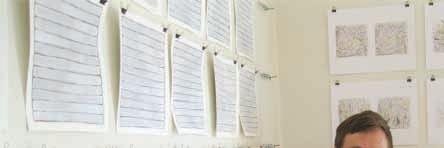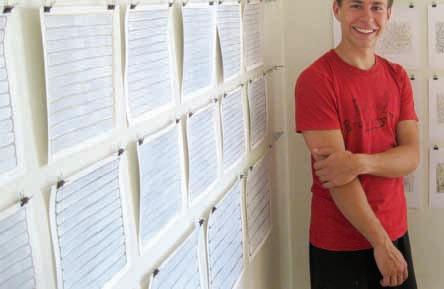
3 minute read
Art of the State
from May 2, 2013
Small time
Nate Clark
Advertisement
Most of Nate Clark’s recent artworks have been large paintings and drawings. After a friend by Brad Bynum jokingly suggested that Clark break up the large pieces into something smaller so his bradb@ poorer friends could afford to buy his art, newsreview.com Clark decided to make a series of artworks in which the larger pieces were composed of many smaller works. The results of this new approach are currently on display in his exhibition Once Again: Three Series of Small Works at the Never Ender Gallery through June 3. The first series is a collection of linen wall works, the second, small acrylic paintings, and the third, a collection of small drawings. nate Clark’s exhibition Clark made the works small partly to once: again: three make them inexpensive and accessible. Series of Small Works Everything in the show is $10 to $30. n is on display at the ever Ender Gallery, “We’ve all gone to a coffee shop and 119 thoma St., 348- seen a bad photograph on sale for $600,” 9440, through June 3. he says. “That really turns people off of For more information, wanting to buy artwork. So I wanted to visit http://nateclark website.com. make something small and affordable. … And I did just quit my job. I hope to sell some work!”
Originally from Olympia, Wash., he moved to Reno to attend the University of Nevada, Reno. He graduated from the university’s BFA program in 2010. He’s a prolific artist. In addition to this exhibition at Never Ender, he has upcoming shows at the McKinley Arts Center in June and the Holland Project in July.
The first series in Once Again, was inspired by a recent trip to visit his girlfriend’s grandfather, a man Clark describes as “a photographer and a storyteller,” who has recently had lung troubles. Each linen piece looks like an oversized, all-white Polaroid with the central piece loose, slightly oversized, and air, like a partially deflated lung or balloon. The pieces seem to invite touching, like bubble wrap.
“I’m all right with that, because I know I’d want to do the same thing,” says Clark, who admits he likes to cop feels on the art in museums.
Series Two consists of small acrylic paintings of stacked rectangular blocks. From six feet away, the blocks look entirely black and white, but closer inspection reveals a variety of colors outlining the rectangles. It’s a nice surprise, nearly the opposite of those disappointing paintings that look great look from across a gallery, but fall apart up close.
“These paintings are just the process of looking,” writes Clark in a gallery artist statement. “The structure helps me find what is next, or where they are headed. They are a study of something, but I do not know what quite yet. It has something to do with craft and a steady hand. It has something to do with color and feeling. I need objects like these in my life to keep me grounded and moving forward at a steady pace.” The final series is a collection of paired drawings, each 4 inches by 4 inches, and each twin a set of inexact replicas. He’d make a mark, or a series of a marks, in one square and then attempt to repeat that same mark in the other square. But he was not totally precise in the recreation—making the same gesture, but allowing for natural variation. The individual drawings are abstract and seemingly chaotic, but paired with the inexact twins, the reveal a sense of order and natural variation.
“I was not totally interested in exact copies,” he says.
“The work lives somewhere between the two squares, somewhere in between,” he writes in an artist statement.
Looking at all the pieces in the gallery, the smaller works seem to be parts of larger wholes, and it’s difficult to imagine how successful the individual small works will look on a wall away from their sisters.
“Well, in that case, I’d encourage people to buy more than one,” says Clark. Ω
Photo/Brad Bynum Artist Nate Clark has been thinking small.









